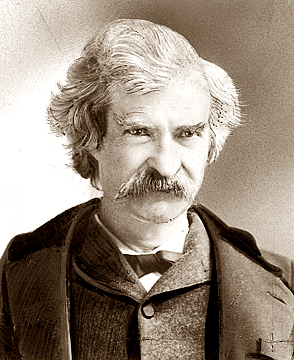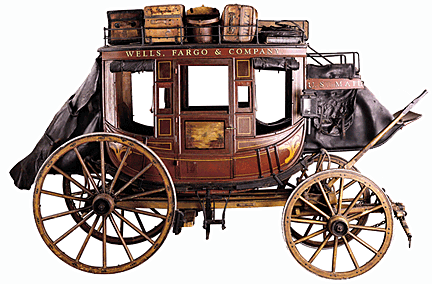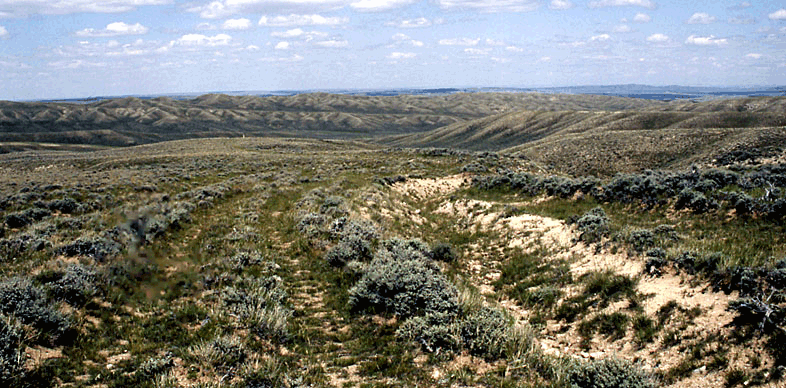| Back in 1865, it cost $150 per person for a one-way ticket to ride the Overland
Stage from St. Joseph, Missouri, to Sacramento, California. Today, it costs about the
same, only the stage has been replaced with a Chevy Blazer, and the portion of the Trail I
sought to find stretched over the barren wastelands of south-central Wyoming.

Today, the Overland Trail is hardly more than a set of faded ruts, with ruins of
century-old stone stations, abandoned in 1868 after seven dismal years. One passenger
said: "A nasty route, steep grades, many rocks, poor water, poor grass. It was three
days across the Laramie Plains at ten miles day, often muddy and boggy. A disaster."
 What may have been a disaster to its passengers has become legend across the plains. To
me, finding the remains of the Trail and its stations became an exploration into history.
Armed with a map and a copy of Mark Twain's book, Roughing It, I began my trek in the
sleepy town of Rawlins, Wyoming. What may have been a disaster to its passengers has become legend across the plains. To
me, finding the remains of the Trail and its stations became an exploration into history.
Armed with a map and a copy of Mark Twain's book, Roughing It, I began my trek in the
sleepy town of Rawlins, Wyoming.
Scarcely a mile from its courthouse, I was very much out on the range, a dispassionate
world of bare rock, brown grass, drab patches of greasewood and scattered colonies of
sage. To the south were gullies and gulches filled with erosional debris, to the north
were ridgelines that ended sharply, like breaking waves.
When Mark Twain traversed the Trail, most of the land west of the Mississippi was wild
territory. Civilization lay far behind. This area of the Rocky Mountains was a paradise of
outlaws and desperados. Violence was the rule. Force was the only recognized authority.
The commonest misunderstandings were settled on the spot with the revolver or the knife.
For me, the backcountry of Wyoming still resembles those wild days, and though
civilization was usually 25 miles or so away, it seemed farther.
From St. Joe to Sacramento by stage was nearly 1,900 miles. The trip usually took 15 days,
but the time specified in mail contracts was 18 or 19 days to allow for winter storms and
snows.
The Overland Stage Company
 The Overland Stage Company had everything under strict discipline. Every 250 miles they
placed a superintendent. This 250-mile stretch was called a "division." He
purchased horses, mules, harness, and food for men and beasts, and distributed these
things among his stage stations from time to time. He also erected station buildings and
dug wells, attended to paying station keepers, hostlers, drivers, and blacksmiths and
discharged them whenever he chose. There were eight of these men along the Overland Route.
The western half was under the control of Ben Holliday. The Overland Stage Company had everything under strict discipline. Every 250 miles they
placed a superintendent. This 250-mile stretch was called a "division." He
purchased horses, mules, harness, and food for men and beasts, and distributed these
things among his stage stations from time to time. He also erected station buildings and
dug wells, attended to paying station keepers, hostlers, drivers, and blacksmiths and
discharged them whenever he chose. There were eight of these men along the Overland Route.
The western half was under the control of Ben Holliday.
Drivers changed horses 10 or 12 times in 24 hours, taking four minutes to do so. As the
coach rattled up to each station, six harnessed horses stepped gaily from the stable, and
before passengers would have time to get out for a stretch, the old team was replaced with
a fresh one and the stagecoach was off again.
This was a paid and maintained trail for stage coaches, unlike the Oregon Trail. Stations
were placed 10 to 15 miles apart, 31 of which were in Wyoming. Today, the Trail swales can
be seen criss-crossing the countryside. Because it wasn't used as heavily as the Oregon
Trail, it's harder to identify.
"We changed horses every ten miles, all day long, and fairly flew over the hard level
road," wrote Twain. "The stage whirled along at a spanking gait, the breeze
flapping its curtains and suspended coats in a most exhilarating way. ...We stretched our
cramped legs full length on the mail sacks and gazed out through the windows across the
wide wastes of green plains clad in a cool, powdery mist."

Overland drivers and conductors used to sit in their places and sleep 30 to 40 minutes at
a time, on good roads, while spinning along at the rate of 8 to 10 miles an hour. There
was no danger to it, a sleeping man will seize the irons in time when the coach jolts.
Matched teams were harnessed with fine tack, the heaviest pair next to the coach. Holliday
chose muscular stock with great size and endurance to pull his Concord Coaches, because of
the steep mountain passes on the Overland Route. These coaches were manufactured by Abbott
and Forwoing of Concord, New Hampshire. Each coach displayed yellow running gear, bright
red bodies with black trim and the Overland Stage Company name emblazoned on the doors in
gold scroll lettering. Most people picture the brown or gray dirty coaches of the movies,
when in actuality, those on the Overland Trail were quite fetching.
Stations Along the Trail
I heard the screech of a kill deer as I approached the ruins of the Washakie station, my
first, across the barren, desolate, wind-blown prairie. The once-bustling station, reached
only by two- mile walk across a sage-covered meadow, dotted with wild onions, purple bells
and other flowers, is now only a pile of ocher-tone rocks, with only a part of one wall
left standing.

Further along the rough dirt Wamsutter Road, part of the Bureau of Land Management's
By-way system, stands Red Rock. This formidable landmark of soft red sandstone looks like
a haystack and is the only place along the Overland Trail with inscriptions. The earliest
ones were from 1852, ten years before the Route was begun. Eagles, nesting on the far side
toward the open prairie, have the best view.
Stations buildings, consisting of barns, a stable-room for a dozen or more horses, and a
hut for an eating room for passengers, were long, low huts, made of sun-dried, mud-colored
bricks, laid up without mortar, called adobes by the Mexicans. Roofs had no slant to them
worth speaking of and were thatched and then soded or covered with a thick layer of
earth, and from this sprung a pretty rank growth of weeds and grass.
The next station I found was Dug Springs. The name came from springs at the station, which
were enlarged or dug to provide improved access to fresh water. This station was 13 miles
west of the Duck Lake station, of which hardly anything remains. The landscape here is
rugged and unforgiving, filled with low-growing salt sage and prickly greasewood. Coming
up over the rise east of the station was the "huff and puff" hill, up which the
horses had to pull extra hard.
The ruins of the Fort La Clede Station are out in the middle of a rocky plain. Formerly an
Army outpost, it's quiet now. Two buildings remain--actually portions built of sandstone
with gun ports. Unlike other stations, this one had gun holes for defense, four on each
side with a room in front and a large room in back, plus a large corral to the right of
the building. There were no sounds, just the wind.
 The best preserved station on the Trail is at Point of Rocks, where the Oregon Trail
passed between two rocky ridges along Bitter Creek. It was referred to as Rock Point and
on early maps as Alwood Station. Wells Fargo called it Point of Rocks, named for the
sandstone ledges rising above it like flying buttresses. From here I had sweeping views,
east over pastel buttes into the sheep country of the Great Divide Basin, and north to the
White Wine River over Steamboat Mountain and the Lucite Hills. Both the Overland and
Oregon Trails, as well as a north-south freight road intersected here. The best preserved station on the Trail is at Point of Rocks, where the Oregon Trail
passed between two rocky ridges along Bitter Creek. It was referred to as Rock Point and
on early maps as Alwood Station. Wells Fargo called it Point of Rocks, named for the
sandstone ledges rising above it like flying buttresses. From here I had sweeping views,
east over pastel buttes into the sheep country of the Great Divide Basin, and north to the
White Wine River over Steamboat Mountain and the Lucite Hills. Both the Overland and
Oregon Trails, as well as a north-south freight road intersected here.
Twain described his visit there in 1886, as always, with a bit of satire, "The rock
chairs and sofas were not present...but they were represented by two to three-legged
stools, a four-foot pineboard bench and two empty candle boxes. The table was a greasy
board on stilts, a battered tin platter, a knife and fork and a tin pint cup were at each
man's place..."
Home stations, offered larger and more commodious quarters, overnight sleeping rooms and
served better food than swing stations. Point of Rocks is a good example of a swing
station. A recluse, and reportedly a former member of Butch Cassidy's "Wild
Bunch," lived in building until he died in 1946.
"In place of a window there was a square hole about large enough for a man to crawl
through but without glass," Twain added. "There was no flooring, but the ground
was packed hard. There was no stove, but the fireplace served all purposes. There were
also no shelves, no cupboards, and no closets. In a corner stood an open sack of flour,
and nestling against its base were a couple of black tin coffeepots. A tin teapot, a
little bag of salt, and a side of bacon.
 "By the door of the station-keeper's hut outside was a tin washbasin, on the ground.
Near it was a pail of water and a piece of yellow bar soap, and from the eaves hung a
hoary blue woolen shirt, the station keeper's private towel--only two persons in the party
were allowed to use it--the stage-driver and conductor. We washed and dried with our
sleeves and hankerchiefs. If passengers were lucky, there might be some sort of mirror but
usually not. "By the door of the station-keeper's hut outside was a tin washbasin, on the ground.
Near it was a pail of water and a piece of yellow bar soap, and from the eaves hung a
hoary blue woolen shirt, the station keeper's private towel--only two persons in the party
were allowed to use it--the stage-driver and conductor. We washed and dried with our
sleeves and hankerchiefs. If passengers were lucky, there might be some sort of mirror but
usually not.
"From the looking-glass frame hung the half of a comb by a string--but if I had to
describe it, I believe I would order some sample coffins," he said.
I could only imagine the colorful, but rough stationmen dressed in their dull blue and
yellow coarse-woven pantaloons and buckskins, their pants stuffed into the tops of high
boots, heels armed with great Spanish spurs, whose little iron clogs and chains jingled
with every step. An old slouch hat and long revolver slung through his belt would have
completed the portrait.
Twain recounted his breakfast at Point of Rocks, "The station keeper up-ended a
disk of last week's bread, of the shape and size of an old-time cheese, and carved some
slabs from it. He sliced off a piece of bacon for each man, but only the experienced old
hands made out to eat it, for it was condemned Army bacon which the US would not feed its
soldiers and the stage company had bought it cheap to feed their passengers and employees.
"He poured a beverage called `Slumgullion' which really pretended to be tea, but
there was too much sand, old bacon rinds and too much dish-rag to deceive the intelligent
traveler. An old broken vinegar cruet with a dozen preserved flies with their heels up in
it. We had all this for a $1 each."
Sometimes if a coach broke down, the passengers even got to go on a buffalo hunt.
Unfortunately, I had no such luck. My Chevy Blazer, encased in a thick coating of red
dust, boar me well. Traveling in air-conditioned comfort with a cooler full of drinks is
the only way to go!
< Back to
History Articles
Go to next History article > |
